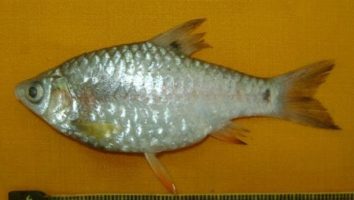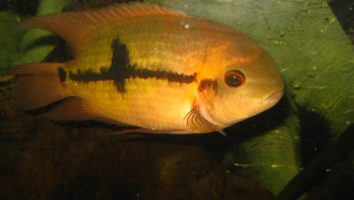Koi are some of the most popular freshwater fish in the world. And for good reason!
They’re absolutely stunning, come in a wide variety of colors and patterns, and can live for decades with proper care.
If you’re thinking about getting koi fish, you’ve come to the right place. In this guide, we’ll teach you everything you need to know about koi care.
You’ll learn about their diet, tank size, lifespan, and more. We’ll even give you some tips on where to buy koi fish.
Table of contents
Species overview
Koi (scientific name: Cyprinus carpio) are a type of domesticated fish that are popular in both Japan and China. They are descendants of the common carp and have been bred for their ornamental value.
Koi are available in a wide variety of colors and patterns, which is one of the main reasons why they’re so popular. You’ll often see them in ponds and water gardens, as they’re very peaceful fish that don’t tend to bother other creatures.
In terms of care, koi are very easy to look after. They’re very resilient and can tolerate a wide range of water conditions. They’re also quite hardy, so they can withstand a fair amount of abuse.
All in all, koi are great fish for both beginners and experienced aquarists alike.
Appearance

The first thing you’ll notice about Koi are their beautiful colors. These fish come in a wide variety of colors and patterns that are truly stunning.
The colors on Koi can range from white to black, and every shade in between. You’ll find solid colors, two-toned colors, and even three-toned colors. The patterns are just as varied with some being more abstract than others.
The second thing you’ll notice about Koi is their size. These fish can grow quite large, with some individuals reaching over three feet in length!
Koi have a torpedo-shaped body that is fairly slender. They have a long dorsal fin that starts about two-thirds of the way back on their body.
The anal fin is much shorter and starts closer to the middle of the fish. Koi also have a forked caudal fin that is fairly tall.
One of the most distinctive features of Koi is their barbels. These are long, thin, and sensory organs that hang down from their mouths. Koi use these barbels to help them find food in murky water.
Lifespan
The typical Koi lifespan is 20-30 years. However, there are records of individual Koi living for over 200 years!
The key to a long life for your Koi is providing them with the best possible care. This includes regular check-ups from a qualified vet, a healthy diet, and a well-maintained pond.
Size
Koi fish can grow to be very large, with some individuals reaching lengths of over 3 feet! However, the average size of a koi is between 2 and 3 feet.
Tank
Tank Size
The minimum tank size for koi is 100 gallons. But, if you want to keep more than one koi fish, you’ll need to add an additional 50 gallons for each fish.
So, if you want to keep three koi fish, you’ll need a 250-gallon tank.
Koi fish are also very messy eaters and produce a lot of waste. For this reason, we recommend you go with a larger tank if possible. This will help to keep the water quality high and minimize the amount of maintenance required.
Water Parameters
Koi are a bit more demanding when it comes to water parameters. They come from slow-moving rivers and ponds in Asia. That means they prefer cooler water with a higher dissolved oxygen content.
You don’t have to maintain quite as precise of conditions as you would for goldfish. But you should still strive for consistency and avoid sudden changes.
Here are a few basic water parameters that will help keep your koi happy and healthy.
- Water temperature: 60 to 75 degrees Fahrenheit
- pH levels: 6.8 to 8.5
- Water hardness: 5 to 30 dGH
- Alkalinity Levels: 5-15 dKH
What To Put In Their Tank
The biggest concern you’ll have to account for when setting up a koi tank is the filtration.
This is a fish that produces a lot of waste, so you’ll need a filter that can handle the load. We recommend something with a canister design since they’re very effective (and not too difficult to maintain).
As for the substrate, koi don’t really care. You can go with gravel, sand, or even bare-bottomed if you want. Just make sure that the material you choose won’t end up in their digestive tract (smooth gravel is a good option).
As for decorations, koi appreciate some plants in their tank. They don’t really nibble on vegetation, but they love to hide in them.
We recommend adding some hardy plants like Anacharis or Hornwort. You can also include some floating plants to help reduce the amount of light that hits the water surface (this will help keep algae growth in check).
Rocks and driftwood are also suitable, but make sure they’re big enough that your koi can’t move them around. These fish are deceptively strong!
Common Diseases
Koi are some of the most hardy and disease-resistant fish you can find. They’re able to withstand a lot of abuse and neglect and still stay healthy.
With that being said, they can still succumb to various diseases and illnesses if they’re not properly cared for.
The most common disease you’ll find in koi is parasites. These can be external (like anchor worms) or internal (like flukes).
Both of these are pretty easy to spot, as you’ll see your fish scratching themselves a lot or see visible parasites on their body.
Another common koi disease is fungal infections. These usually occur in koi that have open wounds or cuts.
You’ll see white patches on the skin of your fish and, if the infection is bad enough, you might even see some fungus growing on the fins or gills.
Bacterial infections are also pretty common in koi. These can be caused by anything from poor water quality to injuries.
The most common symptom of a bacterial infection is red streaks on the body of your fish. If you see this, it’s important to act fast as bacterial infections can spread quickly and be fatal to your koi.
Behavior & Temperament
Koi are some of the most popular fish in the world, and it’s easy to see why. They’re absolutely stunning with their vibrant colors and patterns. But what many people don’t know is that they’re also very intelligent creatures.
Studies have shown that Koi are capable of recognizing individual humans. They can also remember feeding times and will come to the surface to eat when they know it’s time.
Koi are also very social creatures. In the wild, they live in groups and form hierarchies. The same is true in captivity. If you have more than one Koi, they will establish a pecking order.
When it comes to temperament, Koi are generally very calm and peaceful fish. They’re not known for being aggressive or nippy. However, there are always exceptions to the rule. Some Koi can be territorial, especially when it comes to their food.
Tank Mates
Because of their size and potential aggression, Koi are best kept with other fish of their own kind. They can be kept with other fish, but it’s best to avoid mixing species.
If you must mix, then choose fish that are too big to be eaten and can handle living in close quarters.
Some good Koi tank mates include:
- Catfish
- Carp
- Goldfish
- Bitterlings
- Minnows
- Loaches
Breeding
Koi are a type of fish that have been bred for their coloration. There are many different colors of koi, but they all have one thing in common: they’re beautiful to look at.
Koi are not the easiest fish to breed, but it is possible to do it at home. The first step is to set up a breeding tank. This should be a large tank (at least 100 gallons) with a gentle filtration system.
Next, you need to choose your koi. It’s best to choose two fish that are the same size and have similar coloration. This will make it easier to tell when they are ready to breed.
When you have your koi, it’s time to prepare the breeding tank. The water should be clean and the temperature should be between 70 and 80 degrees Fahrenheit. You should also add some live plants to the tank. These will provide shelter for the fry (baby koi).
Once the tank is set up, it’s time to introduce your koi. Place them in the tank and let them acclimate to their new environment.
After a few days, you should start to see the koi “flirting” with each other. This is a good sign that they are ready to breed.
When the koi are ready to breed, the female will lay her eggs in the plants. The male will then fertilize the eggs.
Once the eggs are fertilized, they will hatch in about a week. The fry will be very small and they will need to be fed live food. You can purchase live food at your local pet store.
After a few months, the fry will be big enough to be moved to a regular tank.
Conclusion
Koi care is not difficult, but there are a few things you need to know to keep your fish healthy and happy.
Overall, we think Koi are a great addition to any pond and would recommend them to anyone looking for a beautiful and low-maintenance fish.












